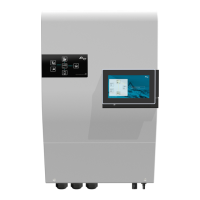Studer Innotec SA
next3
Technical user manual V1.3 © Studer-Innotec SA 33
5.2.7
Battery with communicating BMS: CAN connection
The next3 uses a CAN Bus to communicate with the BMS (Battery Monitoring System) of a lithium
battery. Lithium batteries are more complex to handle compared to lead acid batteries. A BMS is
responsible of cell monitoring and battery safety. The BMS knows the status of each cell, and it
computes maximum charging/discharging currents and maximum/minimum target voltages. These
values must be respected when the installation is working and BMS communicates to
inverter/chargers the proper setpoints for proper operation.
The next3 has several CAN protocols implemented for communication with different battery
management.
These protocols are compatible with specific batteries, as listed in list below:
• AutarcTech
• BlueNova
• BMZ
• BYD
• Cegasa
• Cosun
• Discover
• FreedomWon
• IPS
• Pallas
• PowerTech
• Pylontech
• Soltaro
• SuperB (with BCI)
• TesVolt
• Weco
• …
See the Studer-Innotec website for the up-to-date list of compatible batteries, brand and models
and updates of the next3 software to have the latest communication protocol.
Beware of the pinning order (CANH, CANL, GND) on the connector, see instruction of the BMS
manufacturer carefully. An appendix about various lithim batteries is available.
For a point-to-point connection, the bus termination should be set to T (Terminated). If the device is
in the middle of a daisy chain, the termination is set to O (Open).
Generally, the next3 is connected point to point to the BMS and the termination should be on T.

